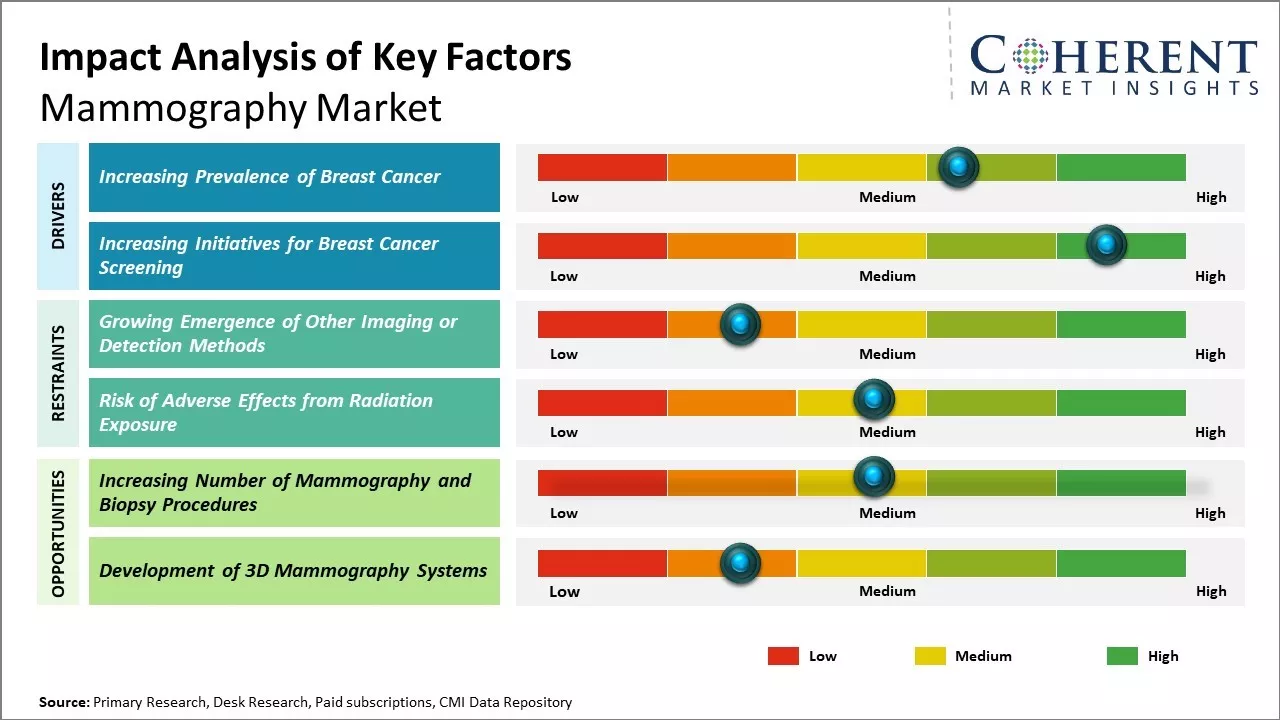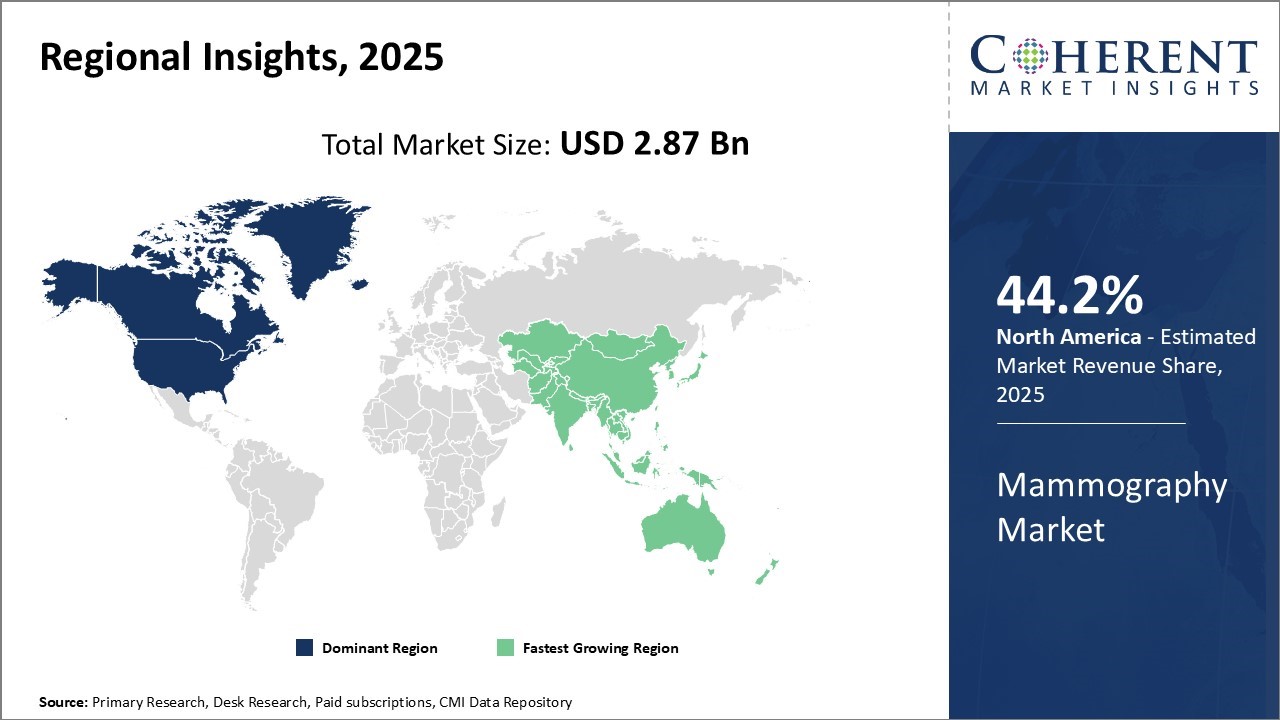The global mammography market is estimated to be valued at USD 2.87 Bn in 2025 and is expected to reach USD 5.74 Bn by 2032, exhibiting a compound annual growth rate (CAGR) of 10.4% from 2025 to 2032.

To learn more about this report, Download Free Sample
The Mammography Market is experiencing significant growth, fuelled by rising breast cancer incidence and increasing emphasis on early detection. Digital systems lead the product segment with a 65.2% share in 2025, driven by advancements in imaging technologies. Breast tomosynthesis dominates by technology with a 54.6% share, owing to its superior diagnostic accuracy. Hospitals remain the key end users, accounting for 36.7% of the market. North America leads regionally with a 44.2% share, supported by strong healthcare infrastructure and screening awareness.
|
Current Event |
Description and its impact |
|
Technological Breakthroughs and Diagnostic Innovation |
|
|
Strategic Partnerships and Market Expansion |
|
|
Regulatory Shifts and Policy Support |
|
Uncover macros and micros vetted on 75+ parameters: Get instant access to report
The reimbursement landscape plays a critical role in driving the adoption of mammography services across global healthcare systems. In developed regions such as North America and Europe, well-established reimbursement frameworks support routine breast cancer diagnostic, significantly increasing patient access to mammography. In the U.S., the Affordable Care Act mandates full coverage for screening mammograms every 1–2 years for women aged 40 and older, without co-payment, under most insurance plans and Medicare.
Similarly, countries like Germany, France, and the UK offer national screening programs backed by public healthcare systems, ensuring broad access to diagnostic services. Reimbursement for advanced techniques such as 3D digital breast tomosynthesis is expanding, as more clinical evidence supports its diagnostic superiority.
Increasing burden/incidence of cancer across the world is expected to augment the growth of the global mammography market during the forecast period. For instance, mammograms are the best way to find breast cancer early, when it is easier to treat and before it is big enough to feel or cause symptoms.
In 2025, approximately 316,950 women will be diagnosed with invasive breast cancer, with 59,080 new cases of ductal carcinoma in situ (DCIS), which is non-invasive. About 16% of women with breast cancer are younger than 50 years of age
In May 2025, WashU Medicine announced that its AI-based breast cancer risk model, which analyzes mammogram images to predict five-year cancer likelihood, received FDA Breakthrough Device Designation. The designation is expected to fast-track regulatory review and clinical adoption, paving the way for more personalized and early intervention strategies in breast cancer care.
Favorable initiatives for breast cancer screening or increase in the number of breast cancer screening programs or campaigns is expected to boost the market growth. For instance, in October 2025, Prerna, a leading healthcare company, launched Cantel, India’s first microRNA-based blood test for breast cancer screening. This innovative test offers a non-invasive, accurate, and early detection method, marking a significant advancement in cancer diagnostics. Cantel aims to improve screening accessibility and outcomes for women across India through cutting-edge molecular technology.
Increasing number of mammography and biopsy procedures is expected to offer significant growth opportunities for players in the global mammography market. For instance, according to the data provided by the U.S. Food & Drug Administration’s (USFDA) Mammography Quality Standards Act’s (MQSA) program, around 39,450,489 total annual mammography procedures were reported globally. Mammography is a specialized medical imaging tool that uses a low-dose x-ray system to see inside the breasts.
The digital systems segment is expected to lead the mammography market by product type, accounting for 65.2% of the total share in 2025. This dominance is driven by rapid technological advancements that have enhanced image resolution, diagnostic speed, and workflow efficiency.
With costs declining and integration capabilities with PACS improving, healthcare providers are increasingly shifting from analog and film-screen systems to digital solutions. The growing demand for real-time diagnostics, especially in urban and semi-urban centres, supports widespread adoption
Breast tomosynthesis is projected to capture 54.6% of the mammography market share by 2025, making it the top technology segment. Its ability to provide 3D imaging improves the detection of small, early-stage tumours while reducing false positives.
This superior diagnostic accuracy has led to widespread acceptance among radiologists and healthcare institutions. Regulatory approvals and supportive clinical outcomes are further propelling its integration into screening programs globally.
Hospitals are set to lead the mammography market by end user, with a projected 36.7% share in 2025. The central role hospitals play in early cancer detection and their access to trained personnel and advanced infrastructure drive this dominance. Government and NGO-led screening programs are largely executed through hospital networks, reinforcing their strategic position. Hospitals also support large-scale deployments of breast imaging equipment, particularly in urban healthcare systems.

To learn more about this report, Download Free Sample
North America is projected to dominate the global mammography market in 2025, securing approximately 44.2% of the total market share. This leadership is driven by a combination of heightened breast cancer awareness, well-established reimbursement frameworks, and a robust healthcare infrastructure that supports early detection and preventive care.
The United States is at the forefront of this regional growth, experiencing a surge in early-stage breast cancer screenings fuelled by national awareness initiatives, such as Breast Cancer Awareness Month, and the widespread availability of advanced imaging technologies like digital mammography and breast tomosynthesis.
North America also benefits from the strong presence of leading medical device manufacturers and continuous technological innovations in diagnostic imaging. Favourable regulatory support, high healthcare spending, and the integration of AI and digital tools into imaging systems are further accelerating market penetration. With these strengths, the region is expected to remain the benchmark for mammography adoption and innovation through 2025 and beyond.
The United States leads the global mammography market, significantly contributing to North America’s projected 44.2% market share in 2025. This dominance stems from a highly developed healthcare infrastructure, extensive breast cancer awareness campaigns, and favourable reimbursement frameworks.
The country has seen a substantial rise in early-stage breast cancer screenings, driven by national initiatives such as Breast Cancer Awareness Month and widespread access to cutting-edge imaging technologies like digital mammography, 3D tomosynthesis, and AI-powered diagnostic tools.
With a high concentration of major medical device manufacturers and continuous investment in research and innovation, the U.S. continues to set the pace for technological advancement and market growth. Supportive FDA regulations, integration of digital health platforms, and a proactive approach to preventive healthcare further reinforce its position as the global leader in the mammography landscape.
| Report Coverage | Details | ||
|---|---|---|---|
| Base Year: | 2024 | Market Size in 2025: | USD 2.87 Bn |
| Historical Data for: | 2020 To 2024 | Forecast Period: | 2025 To 2032 |
| Forecast Period 2025 to 2032 CAGR: | 10.4% | 2032 Value Projection: | USD 5.74 Bn |
| Geographies covered: |
|
||
| Segments covered: |
|
||
| Companies covered: |
Carestream Health, Siemens Healthineers, Planmed Oy, Konica Minolta Inc., Metaltronica SpA, Koninklijke Philips N.V., General Medical Merate SpA, Hologic Inc., GE Healthcare, Fujifilm Holdings Corporation, Analogic Corporation, Canon Medical Systems Corporation, and Toshiba Medical Systems |
||
| Growth Drivers: |
|
||
| Restraints & Challenges: |
|
||
Uncover macros and micros vetted on 75+ parameters: Get instant access to report
Share
Share
About Author
Komal Dighe is a Management Consultant with over 8 years of experience in market research and consulting. She excels in managing and delivering high-quality insights and solutions in Health-tech Consulting reports. Her expertise encompasses conducting both primary and secondary research, effectively addressing client requirements, and excelling in market estimation and forecast. Her comprehensive approach ensures that clients receive thorough and accurate analyses, enabling them to make informed decisions and capitalize on market opportunities.
Missing comfort of reading report in your local language? Find your preferred language :
Transform your Strategy with Exclusive Trending Reports :
Frequently Asked Questions
Joining thousands of companies around the world committed to making the Excellent Business Solutions.
View All Our Clients